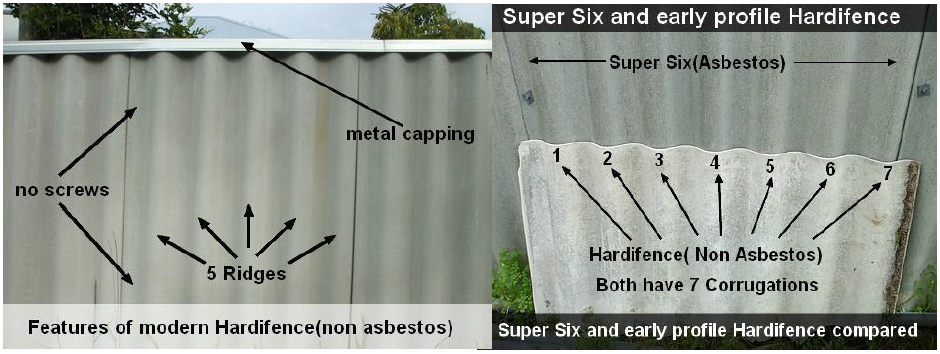Is it asbestos or Hardie Fence?
Telling the difference between Super 6 (Asbestos) an Hardiefence (fibre cement board)
Info from:
HOW TO TELL THE DIFFERENCE BETWEEN SUPER SIX AND HARDIFENCE
To the untrained eye, Super Six and Hardifence look quite similar. However, dealing with Super Six requires special precautions to be taken during its handling and for its disposal due to its asbestos content. Be careful not to dispose of any Super Six sheeting in general waste or skip bins not designed for asbestos disposal, as you risk being charged not only an asbestos disposal fee but a potential fine of $1000 for illegal asbestos disposal.
Is it asbestos Super Six or modern Hardifence?
Six tips to identify Super Six (asbestos) and Hardifence (non-asbestos).
1. Age of the House
Houses built during the late 80’s and onwards are far less likely to have asbestos Super Six fencing installed. Older buildings are far more likely to contain Super Six, which may have been installed in the 60’s or 70’s.

2. Count the Ridges
The latest version of Hardifence has 5 ridges which is a sure sign of being the asbestos free Hardifence rather than Super Six which has 7 ridges. However, to make matters confusing, early versions of Hardifence have the same profile (7 ridges) as Super Six.
3. Markings
If possible, examine the edge of the sheet to see any identifiable markings. Hardifence has “Hardifence” printed along with a date of manufacture. Early styles of Hardifence have “Manufactured without asbestos” and a manufacturing date mark.

4. Capping
If the fence is fitted with fibre cement capping, then it’s a sure sign that the fence is asbestos. However, if the fence has metal capping then it’s most likely the fence is Hardifence and does not contain asbestos.
The most recent version of Hardifence is always fitted with metal capping as this is an integral part which keeps the sheets from separating at the top. However, bear in mind that there are plenty of fences where no capping is fitted at all.

5. Fingernail Scratch Test
Use your fingernail to scratch the surface of the sheet. If you can gouge a mark in it, then this is a good indicator of being Hardifence rather than Super Six. Generally Hardifence is slightly softer than Super Six.

6. Appearance of Fibres
If a section of fencing has a broken corner or edge, you can examine the material composition to determine whether it is asbestos cement. Whilst asbestos fibres are microscopic, the asbestos fibre used in the manufacturing process of asbestos cement sheeting was in large clumps or bundles. These fibrous bundles can be seen sticking out near a breakage point or sometimes on an edge of the sheet
By contrast, the cellulose fibres used in Hardifence tend to be bonded more uniformly and fibre lengths tend to be shorter and not as strong. As a result, broken edges of Hardifence almost resemble the appearance of torn cardboard with a soft fuzzy edging. In addition, broken edges of Hardifence may tend to have a layered appearance, probably due to the manufacturing process.
Utilisation of a macro mode on a digital camera or smart phone can aid you in this process, providing a clear and magnified image.

7. Laboratory Testing
If all else fails, you can take samples to a certified testing laboratory where they can be examined microscopically for asbestos. Various laboratories which provide this service can be found online under analytical services.
